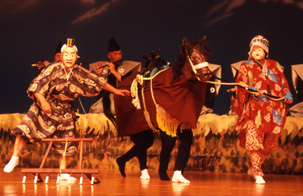
| Pseudonym reading | Inside |
|---|---|
| Specified type | Prefecture designation |
| Type | Intangible folk cultural property |
| Designated date | January 4, 1983 |
| Specified details | |
| quantity | |
| location | Kitakami city Ezuriko Daibo |
| owner | |
| Holding group | Haruta hitting preservation society |
| Management organization | |
| home page | Folk art of Kitakami city |
Overview
Haruta Hitoshi is the only form of field play in the prefecture, and is rare even in Japan. The feature of medieval arts is often left also from the form which plays an easy gesture mainly. Tensho 4 (1576), when Nitobe Tsushima Lori Shigeru conquered Ezuriko Seven thousand Kari, when he built a single hall (the present "Totosan Nitotoji Temple") that enshrined Moritol of the Nitobe family generations here. It is said that the beginning was to have the farmers in the district perform this spring field strike as a celebration, and to celebrate the rich harvest. The program is in the order of "fielding," "seeding," "fielding," "planting," "rice harvesting," and "god of the field." It is composed of two men, Taiko and Taira, one Tairai, and nine dancers. The song-raising and screeching are performed by Tayu, and the progression starts on Tayu's front mouth, and at the beginning of each performance there is a gentle dance that goes around on both sides and steps in four directions. After this, the state of the farmer is simulated and played comically in a comical manner. Finally, the god of the field of the white birch comes out and dances with the godly song. Performed within the district during the Lunar New Year period and at the Ezuriko Furudate Festival on September 23.
Main performance place
Ancient Tomb Festival (September)
